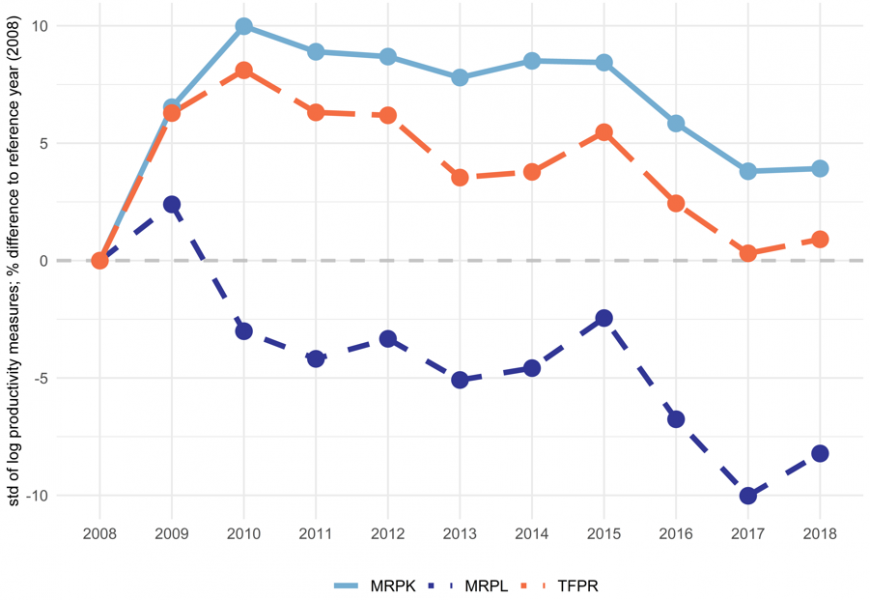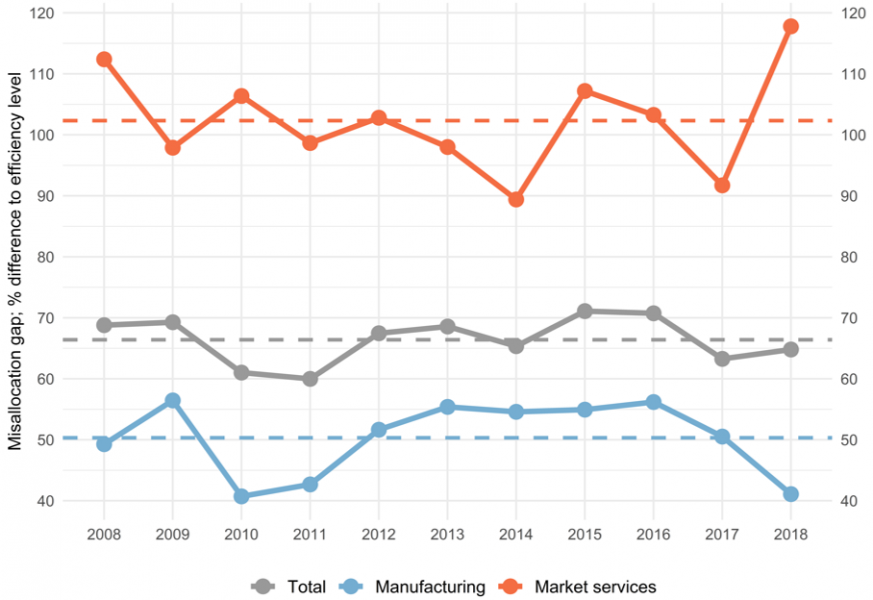References
Akcigit, U. and Ates, S. T. (2021). Ten facts on declining business dynamism and lessons from endogenous growth theory. American Economic Journal: Macroeconomics, 13(1):257–98.
Baqaee, D. R. and Farhi, E. (2020). Productivity and misallocation in general equilibrium. Quarterly Journal of Economics, 135(1):105–163.
Bloom, N., Jones, C. I., Van Reenen, J., and Webb, M. (2020). Are ideas getting harder to find? American Economic Review, 110(4):1104–44.
Bouche, P., Cette, G., and Lecat, R. (2021). News from the frontier: Increased productivity dispersion across firms and factor reallocation. Working papers 846, Banque de France.
Breyer, P., Endlich, E., Huber, D., Oswald, D., Prenner, C., Reiss, L., Schneider, M., and Waschiczek, W. (2021). Corporate equity finance in Austria – impediments and possible improvements. Monetary Policy & the Economy, Q3/21:39–57.
Bun, M. and de Winter, J. (2022). Capital and labor misallocation in the Netherlands. Journal of Productivity Analysis, 57:93–113.
Bun, M., Kolaiti, T., Özden, T (2023). Misallocation and Productivity Growth: a Meta-analysis. De Nederlandsche Bank Working Paper No. 774.
Commission, E. (2022). Country Report Austria – 2022. SWD (2022) 601 final, European Commission.
David, J. M. and Venkateswaran, V. (2019). The sources of capital misallocation. American Economic Review, 109(7):2531–67.
Decker, R. A., Haltiwanger, J., Jarmin, R. S., and Miranda, J. (2020). Changing business dynamism and productivity: Shocks versus responsiveness. American Economic Review, 110(12):3952–90.
Dias, D. A., Robalo Marques, C., and Richmond, C. (2016). Misallocation and productivity in the lead up to the eurozone crisis. Journal of Macroeconomics, 49:46–70.
Duarte, M. and Restuccia, D. (2010). The Role of the Structural Transformation in Aggregate Productivity. The Quarterly Journal of Economics, 125(1):129–173.
Gamberoni, E., Giordano, C., and Lopez-Garcia, P. (2016). Capital and labour (mis)allocation in the euro area: some stylized facts and determinants. Working Paper Series 2419, European Central Bank.
Gopinath, G., Kalemli-Ozcan, S., Karabarbounis, L., and Villegas-Sanchez, C. (2017). Capital Allocation and Productivity in South Europe. Quarterly Journal of Economics, 132(4):1915–1967.
Hopenhayn, H., Neira, J., and Singhania, R. (2022). From population growth to firm demographics: Implications for concentration, entrepreneurship and the labor share. Econometrica, 90(4):1879–1914.
Hsieh, C.-T. and Klenow, P. J. (2009). Misallocation and Manufacturing TFP in China and India. The Quarterly Journal of Economics, 124(4):1403–1448.
Liu, E., Mian, A., and Sufi, A. (2022). Low interest rates, market power, and productivity growth. Econometrica, 90(1):193–221.
Loecker, J. D., Eeckhout, J., and Unger, G. (2020). The Rise of Market Power and the Macroeconomic Implications. The Quarterly Journal of Economics, 135(2):561–644.
OECD (2021). OECD Economic Surveys: Austria 2021. OECD Publishing, Paris.
Peneder, M. and Prettner, C. (2021). Entwicklung der Produktivität österreichischer Unternehmen von 2008 bis 2018 – Auswertung von Mikrodaten für Österreich im Rahmen von Multiprod 2.0. Studie im Autrag des Bundesministeriums für Digitalisierung und Wirtschaftsstandort.
Restuccia, D. and Rogerson, R. (2013). Misallocation and productivity. Review of Economic Dynamics, 16(1):1–10. Special issue: Misallocation and Productivity.
Restuccia, D. and Rogerson, R. (2017). The causes and costs of misallocation. Journal of Economic Perspectives, 31(3):151–74.
Sellner, R., Pintar, N. and Ernst, N. (2023): Resource Misallocation and TFP Gap Development in Austria. OeNB Work Paper No. 246, Oesterreichische Nationalbank.




